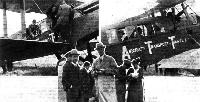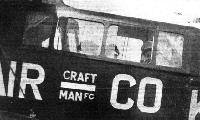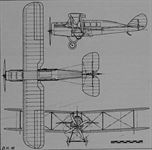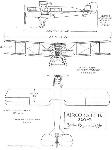
Описание
Страна: Великобритания
Год: 1919
Варианты
- De Havilland - D.H.9 - 1917 - Великобритания
- De Havilland - D.H.9A - 1918 - Великобритания
- De Havilland - D.H.15 Gazelle - 1919 - Великобритания
- De Havilland - D.H.16 - 1919 - Великобритания
- De Havilland - D.H.9B / D.H.9C - 1919 - Великобритания
- LWF - J-2 / Twin DH - 1919 - США
- De Havilland - D.H.9J - 1926 - Великобритания
- A.Jackson De Havilland Aircraft since 1909 (Putnam)
- A.Jackson British Civil Aircraft since 1919 vol.1 (Putnam)
- Журнал Flight
-
A.Jackson - De Havilland Aircraft since 1909 /Putnam/
K-130, first of Aircraft Transport and Travel Ltd.'s Eagle engined D.H.16s, making a 'Joy Loan' pleasure flight at Harrogate on June 9, 1919.
-
Журнал - Flight за 1919 г.
SOME MORE BRITISH MACHINES AT THE E.L.T.A. AERODROME: 1. The Airco 16. This machine is shown on the Airco stand minus its wings
-
Журнал - Flight за 1919 г.
SIDE VIEW OF THE NEW AIRCO (DE HAVILLAND) PASSENGER CARRIER. - As the illustration shows, there is seating accommodation in the cabin for four passengers. The engine is a 350 h.p. Rolls-Royce, and with full complement of passengers the machine has a speed of 126 m.p.h. Mr. M. D. Manton is seen in the pilot's seat
-
A.Jackson - British Civil Aircraft since 1919 vol.1 /Putnam/
One of the Lion engined D.H.16s of Aircraft Transport and Travel Ltd. at Croydon in 1920.
-
P.Jarrett, K.Munson - Biplane to Monoplane: Aircraft Development, 1919-39 /Putnam/
The four-passenger Airco/de Havilland D.H.16 operated Aircraft Transport and Travel's first cross-Channel scheduled passenger service, on 25 August 1919.
Passenger entry to the cabin of the D.H.16 was similar to that of the D.H.4A - via an external ladder and hinged roof. -
Журнал - Flight за 1919 г.
THE AIRCO 16: This photograph shows the cabin of the standard machine which has been used extensively on the London-Paris air service. The Show machine is similar, except for the engine, which is a 450 h.p. Napier Lion
-
Журнал - Flight за 1919 г.
THE LONDON-PARIS AIR SERVICE: Start of the service for Paris from Hounslow Aerodrome on August 25. The Airco machine embarking its passengers, and on the right the first Airco machine just leaving for the journey. Below Gen. F H. Sykes and Gen. Festing, who were present at the inauguration of the service.
-
Журнал - Flight за 1919 г.
THE LONDON-PARIS AIR SERVICE: (1) A de H. (Airco) 16 arrives from Paris, carrying, among others, Miss Edie Thomas, the American concert singer. (2) Lieut. H. Shaw descending from his Airco 16 after piloting a load of passengers safely across from Paris. (3) One of the Airco 16 machines used on the London-Paris service.
-
A.Jackson - De Havilland Aircraft since 1909 /Putnam/
The D.H.16 G-EALU "Arras" with which Capt. H. 'Jerry' Shaw inaugurated the first K.L.M. Croydon-Amsterdam service on May 17, 1920.
-
A.Jackson - De Havilland Aircraft since 1909 /Putnam/
The penultimate D.H.16 G-EARU. c/n P.59, showing the Napier Lion installation.
-
Журнал - Flight за 1919 г.
A French lady designer of one of the greatest London emporiums goes a flipping at Hendon in a D.H. enclosed machine, no doubt with designs on designs aviatic.
-
Журнал - Flight за 1919 г.
THE AIRCO (DE H.) 16. - On the left a lady passenger is seen, on the side ladder, entering the cabin, and, on the right, a view looking into the cabin, showing how the four seats are arranged
-
Журнал - Flight за 1919 г.
THE D.H. (AIRCO) 16 MACHINES USED ON THE LONDON-PARIS ROUTE: Plan, side and front elevations to scale.
-
Журнал - Flight за 1919 г.
The Airco (D.H.) 16, 450 h.p. Napier Lion
A.Jackson De Havilland Aircraft since 1909 (Putnam)
De Havilland D.H. 16
Early in 1919 the Aircraft Manufacturing Co. Ltd. were already considering the type of aircraft best suited to the era of civil flying which lay ahead. Experience gained in converting the rear cockpit of the military D.H.4 into a cabin for two passengers and successful operation of the resultant D.H.4A by R.A.F. Communications Squadrons, undoubtedly influenced their decision to build a somewhat larger machine in the same configuration. The D.H. 16, Airco's first purely civilian type, was consequently built from D.H.9A instead of D.H.4 components and the rear fuselage was widened to seat four passengers in facing pairs in a glazed cabin. Although powered by the 320 h.p. Rolls-Royce Eagle VIII engine of its predecessor, it was faster and carried four instead of two fare paying passengers, making it a considerably more economical and commercially attractive aircraft.
The prototype first flew at Hendon in March 1919 in contemporary khaki drab with red, white and blue rudder. In the following May it entered service with Aircraft Transport and Travel Ltd. bearing the temporary civil marking K-130. With 'Joy Loan' advertisements painted under the wings, it toured the provinces, visiting among other places Harrogate where pleasure flights were given on Whit Monday, June 9, 1919. Thus although the D.H. 16 was inspired by the military D.H.4A, it antedated the entry into service of the first civil D.H.4A by two and a half months. In July 1919 the D.H.16 flew to Amsterdam where it was immaculately polished and shown without mainplanes on the Airco stand at ELTA, the First Air Traffic Exhibition. Bearing the nationality mark G on the rudder, the same aircraft, piloted by Major Cyril Patteson, was, on August 25th, used to fly the inaugural scheduled London - Paris service.
Before production ceased in June 1920, nine D.H. 16s had been constructed, one of which was experimentally fitted with air brakes and flaps. One was sold to the Sociedad Rio Platense de Aviacion (River Plate Aviation Co. Ltd.) at Buenos Aires for a highly successful cross river ferry to Montevideo but the remainder were used on the Continental services of Aircraft Transport and Travel Ltd. The final three were fitted with the heavier and more powerful Napier Lion engine and although in the opinion of some pilots the increase in wing loading made them tricky to handle, they set up new standards in reliability. During one week in the summer of 1920 the Lion engined D.H. 16 G-EAQS made seven return trips between Croydon and Paris within six days, making fastest time of the week in each direction.
In those days K.L.M., the Royal Dutch Air Line, had no aircraft of its own, so that the honour of making the first K.L.M. scheduled service between Croydon and Amsterdam fell to Capt. H. 'Jerry' Shaw and the Eagle powered D.H.16 G-EALU "Arras". This flight took place in extremely bad weather on May 17,1920 and carried two British journalists, a bundle of English newspapers and a congratulatory letter from the Lord Mayor of London to the Burgomaster of Amsterdam, in a flight time of 135 minutes. K.L.M. schedules were thereafter all flown by Aircraft Transport and Travel Ltd., but when the firm closed down in December 1920, its aircraft, including seven surviving D.H.I6s were stored in a Bessoneau hangar at Croydon, where all but two were broken up in 1922.
The exceptions, G-EALM and 'FT, were taken over by the de Havilland Aeroplane Hire Service in 1922 and after overhaul at Stag Lane went to Lympne for use on early morning newspaper flights to Ostend. A brisk business was also done in bringing back four casual passengers per trip at ?3 a head. The D.H.16s were later based at Stag Lane, ready to go anywhere at ?11 per hour.
On December 5, 1922 both D.H.16s took part in an early air freight experiment by flying consignments of a special Ulster edition of The Times from Sealand to Aldergrove on the day of issue, but after G-EALM crashed near Stag Lane during a test flight on January 10, 1923 with the loss of the pilot, R. E. Keyes, G-EAPT was dismantled and the type became extinct.
SPECIFICATION AND DATA
Manufacturers: The Aircraft Manufacturing Co. Ltd., Hendon, London, N.W.9
Power Plants:
One 320 h p . Rolls-Royce Eagle VIII
One 450 h.p. Napier Lion
Dimensions:
Span 46 ft. 51 in.
Height 1 1 ft. 4 in.
Length 31 It. 9 in,
Wing area 489 3/4 sq. ft.
* Weights: Tare weight 3.155 lb. All-up weight 4.750 lb.
* Performances:
Maximum speed 136 m.p.h. Cruising speed 100 m.p.h.
Initial climb 1,000 ft. min. Ceiling 21.000 ft.
Range 425 miles
* With Napier Lion engine.
Production:
Constructor's No. C. of A.
and Registration Issued Remarks
No. 1 K-130 25.5.19 Later G-EACT. crashed 3.20
No. 4 G-EALM 9.9.19 Crashed at Stanmore. Middlesex 10.1.23
P.1 G-EALU 22.9.19 "Arras" to de Havillands 8.22
P.2 G-EAPM 28.11.19 "Agincourt" to de Havillands 8.22
P.3 G-EAPT 8.12.19 Dismantled by de Havillands 7.23
P.4 G-EAQG 24.1.20 To the River Plate Aviation Company. Buenos Aires 4.20; later registered R-137
P.5E G-EAQS 29.3.20 Aircraft Transport and Travel Ltd., scrapped 1922
P.59 G-EARU 21.5.20 -"-
P.6 G-EASW 30.6.20 -"-
Описание:
















